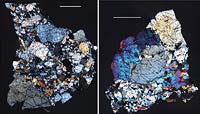|
COMETS EARTH JUPITER KUIPER BELT MARS MERCURY METEORITES NEPTUNE OORT CLOUD PLUTO SATURN SOLAR SYSTEM SPACE SUN URANUS VENUS ORDER PRINTS
PHOTO CATEGORIES SCIENCEVIEWS AMERICAN INDIAN AMPHIBIANS BIRDS BUGS FINE ART FOSSILS THE ISLANDS HISTORICAL PHOTOS MAMMALS OTHER PARKS PLANTS RELIGIOUS REPTILES SCIENCEVIEWS PRINTS
|
Related Documents
Download Options
The HED (howardite, eucrite and diogenite) meteorites are a large group of meteorites believed to originate from Vesta, a hypothesis that is consistent with current Dawn observations. The diogenites originated deep within the crust of Vesta and resemble rocks, both in texture and composition, which we find in the lower crust of the Earth. The QUE 99050 (left) and GRA 98108 (right) diogenites, pictured here, were recovered in Antarctica. These images are of thin slices of the meteorites as viewed through a polarizing microscope. The white bars in the images, each 2 millimeters long, indicate the scale. When polarized light passes through thin slices of rock, different minerals have different colors. QUE 99050 (left) consists of large gray and yellow crystals of pyroxene (magnesium-iron silicate) and is a subgroup of diogenite called "orthopyroxenitic diogenite" (orthopyroxenite is the name of a rock composed primarily of the mineral orthopyroxene). GRA 98108 (right) has a more mafic (i.e. magnesium and iron rich) mineralogy, consisting of roughly equal portions of pyroxene and the much brighter colored olivine, a silica-poor iron magnesium-iron silicate. This olivine-rich "harzburgitic diogenite" (harzburgite is the name given to a rock composed of a mixture of the minerals orthopyroxene and olivine) is thought to represent the most deep-seated rocks from Vesta that we have in the meteorite collection. Diogenites like these comprise some fraction of Vesta's lower crust, and their compositions can be compared with observations from various instruments aboard Dawn. They can be compared with the VIR (Visible and Infrared Imaging Spectrometer) spectra to determine mineralogy and with the GRaND (Gamma Ray and Neutron Detector) observations to calibrate and interpret the GRaND instrument's responses. Similar rocks have likely been excavated by large impacts, such as the one that formed the Rheasilvia basin at the south pole of Vesta. |
